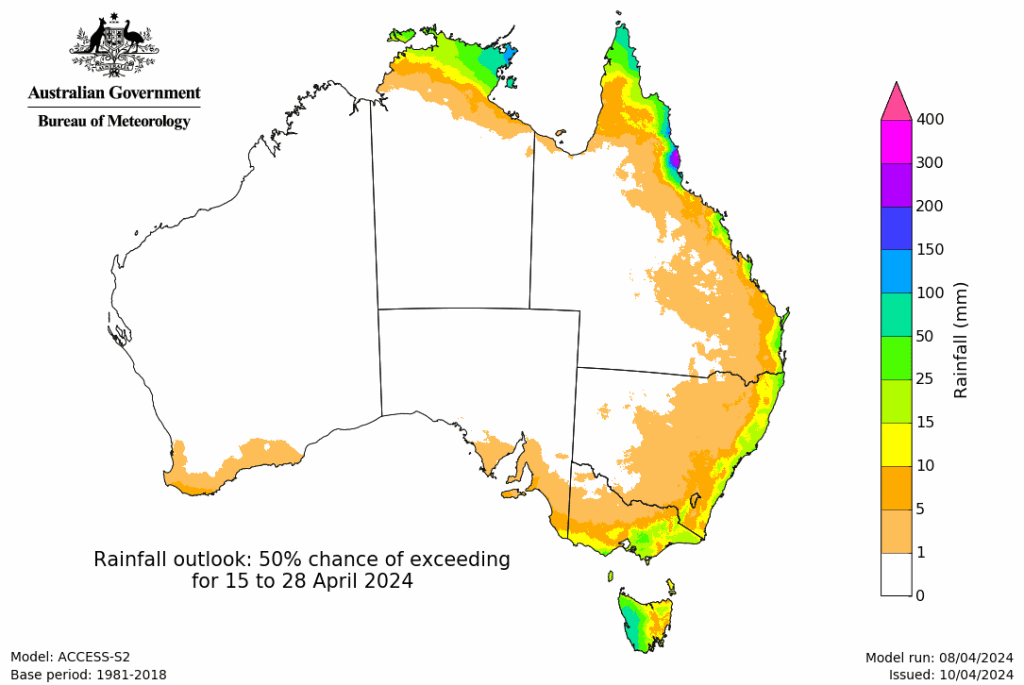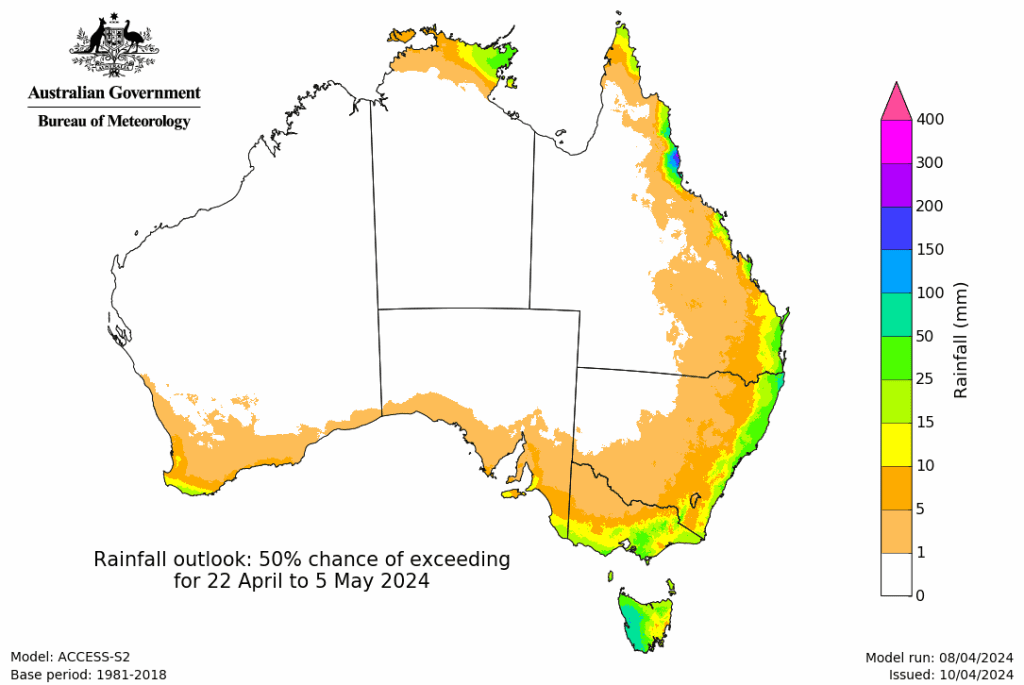
MAY to July maximum and minimum temperatures are very likely to be above median for most of Australia, with a 50pc chance of significant rain occurring in some eastern mainland coastal areas in the next three weeks, the Bureau of Meteorology has forecast.
In its latest rainfall and long-range temperature forecast, the bureau this week said May to July maximum and minimum temperatures have a greater than 50 percent chance of being unusually warm for most of Australia.
May to July rainfall is also likely to very likely to be below median for parts of northern Australia and small areas of the southern mainland, with a 50pc chance of significant rain occurring in some eastern mainland coastal areas from 15 April to 5 May.
The long-range forecast is influenced by several factors, including record-warm oceans globally and a decaying El Niño, the bureau said.
Below median May to July rainfall likely for northern Australia
The bureau has forecast that May rainfall is likely to very likely (60 percent to greater than 80pc chance) to be below median for most of Australia excluding parts of the east and western Western Australia where there is an about equal chance of below and above median rainfall.
May to July rainfall is likely to very likely (60pc to greater than 80pc chance) to be below median for most of northern Australia and small areas of southern Australia. Rainfall is likely (60-80pc chance) to be above median for the western Gascoyne of WA, and scattered parts of eastern and central Australia.
Much of the rest of Australia has about an equal chance of above and below median rainfall, the bureau said.
For May, the chance of unusually low rainfall is above 50pc for parts of northern WA, most of the Northern Territory, and western Queensland. Unusually low rainfall is defined as the driest 20pc of May to July periods from 1981 to 2018.
For May to July, the chance of unusually low rainfall is above 50pc for parts of far northern Australia, although this is the dry season for that region. Unusually low rainfall is defined as the driest 20pc of May to July periods from 1981 to 2018.

Warmer May to July days and nights likely to very likely for much of Australia
For May, maximum temperatures are likely to very likely (60pc to greater than 80pc chance) to be above median for most of Australia except the Carpentaria and Daly districts of the NT, the bureau said.
For May to July, maximum temperatures are very likely to be above median (greater than 80pc chance) for
The bureau said May minimum temperatures are likely to very likely (60pc to greater than 80pc chance) to be above median for most of WA, Tasmania, the northern two-thirds of the NT, northern and eastern Queensland, eastern NSW, and southern and eastern Victoria.
For May to July, minimum temperatures are likely to very likely (60pc to greater than 80pc chance) to be above median for Australia, the bureau said.
For May, the western half of WA and parts of northern and eastern Queensland have at least a 50pc chance of unusually high maximum temperatures. Unusually high maximum temperatures are defined as the warmest 20pc of May to July nights from 1981 to 2018.
For May to July, much of Australia except parts of northern NT and Queensland have at least a 50pc chance of unusually high maximum temperatures, the bureau said. Unusually high maximum temperatures are defined as the warmest 20pc of May to July days from 1981 to 2018.
The bureau said for May, unusually high minimum temperatures have at least a 50pc chance of occurring for western and south-western WA, and parts of northern Queensland. Unusually high minimum temperatures are defined as the warmest 20pc of May to July nights from 1981 to 2018.
For May to July, much of Australia except central to southern parts have at least a 50pc chance of unusually high minimum temperatures. Unusually high minimum temperatures are defined as the warmest 20pc of May to July nights from 1981 to 2018.
El Niño near to ending with most models predicting a La Niña event by late winter
El Niño continues to decline and is near its end, the bureau said. Climate models indicate sea surface temperatures in the central tropical Pacific are expected to return to ENSO-neutral later in autumn 2024.
Global sea surface temperatures have been the warmest on record for each month between April 2023 and March 2024. Notably, the Atlantic Ocean is showing exceptional and prolonged warmth in sea surface temperatures.
Four out of seven international models are predicting a La Niña event by late winter; however, El Niño and La Niña predictions made in early autumn tend to have lower accuracy than predictions made at other times of the year. This means that current forecasts of the ENSO state beyond May should be used with caution.
Source – Bureau of Meteorology.



HAVE YOUR SAY